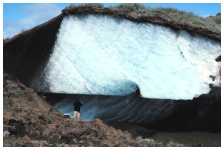
 A Big Earth Pimple There are two main types of ground ice in the Arctic: structure-forming ice that holds land and soil particles together, and large bodies of more or less pure ice. The pure ice exists mainly in the upper part of the ground in the form of pingo cores, icy beds, and ice wedges. A "pingo" is a mound or hill, consisting of an outer layer of soil covering a core of solid ice. It's sort of like a big Earth pimple on the Arctic landscape. The mounds range in size from as small as a car to as large as a domed sports stadium, and large pingos are usually formed over thousands of years. Pingos form because of permafrost (soil that remains frozen for at least two years) and this frozen ground forms a barrier to artesian groundwater (water under pressure that wants to flow upward). Water sometimes gets through that barrier and bubbles up through small cracks in the frozen ground. If the climate is cold enough, the spring water will freeze in the permafrost before it reaches the surface, creating a buried core of ice that lifts large amounts of soil as it expands.
Click pictures for more information and credits. Library: Arctic, Land, Ice Environment/Atmosphere Links: Arctic Arctic Maps & Weather Reports |

|
DICTIONARY: Just "double-click" any unlinked word on this page for the definition from Merriam-Webster's Student Electronic Dictionary at Word Central. |

|
ARCTIC LIBRARY & GLOSSARY: Check this section for an index of the rest of the things you really need to know about the Arctic. |

|
ARCTIC MAPS & WEATHER REPORTS: Maps of the Northwest Passage, explorers' routes, iceberg sources, Nunavut, the Arctic by treeline, temperature... |

|
ARCTIC LINKS: Even more information! Links to sites related to the Arctic and "Iceberg: the Story of the Throps and the Squallhoots". |

|
GUIDE TO ARCTIC SUNRISE & SUNSET: How much sunlight or darkness is there in the Arctic on each day of the year? |
to is the property of their respective owners, and Athropolis is not responsible for their content.